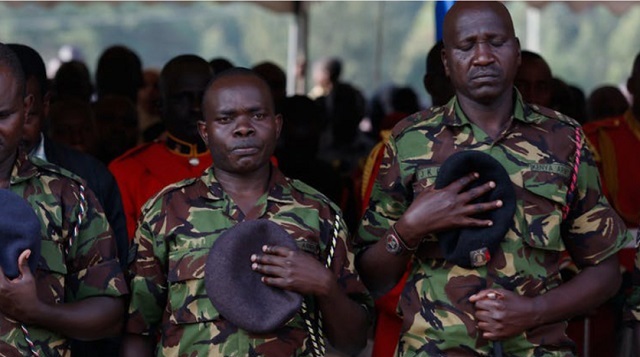
For the first time, a reliable count on how many fatalities AMISOM has suffered
| PAUL D. WILLIAMS | New evidence has made possible a more accurate estimate of how many African Union Mission in Somalia (AMISOM) personnel have died since the mission deployed in March 2007. My previous report in 2015 made clear that neither of the most widely utilised armed conflict databases—the Uppsala Conflict Data Program or the Armed Conflict Event and Location Data (ACLED) project—provided plausible numbers, and that it was unlikely that AMISOM had lost “up to 3,000” or “perhaps over 4,000” peacekeepers as some reports suggested.
This new evidence comes from my research into the mission, newly-released financial statements from the African Union (AU) from 2014 to 2018, a new dataset listing attacks on peacekeepers, and the erection of a “Memorial Wall of Our Heroes” in the AU’s Peace and Security building, which lists names of peacekeepers who died during AU-led and AU-authorised peace operations.
The costs of don’t ask, don’t tell
Four years after my initial investigation, there is still no comprehensive public record of AMISOM’s fatalities. In my book—Fighting for Peace in Somalia—I estimate that the number of AMISOM fatalities between March 2007 and mid-2017 was “probably more than 1,500,” but due to incomplete information, it was impossible to provide a definitive figure. The AU continues to leave the decision on whether or not to release information about casualties to the respective troop-contributing countries (TCCs). To date, no AMISOM TCC has publicly released a comprehensive list of their personnel killed in Somalia.
I maintain that this is not a good policy for two main reasons. First, all peacekeepers who make the ultimate sacrifice should have their service publicly recognised. Not doing so is not only immoral, but it is likely to have a negative effect on morale and could put their next of kin in a difficult position when it comes to claiming the financial compensation they are entitled to. This is presumably part of the reason why the AU recently erected the memorial wall (see below).
Second, not releasing full details about peacekeeper deaths in Somalia plays into al-Shabaab’s hands, who are often able to dominate the media terrain in the absence of an authoritative and trusted AU or AMISOM voice. Optimal strategic communications for a peace operation like AMISOM would involve the mission’s representatives becoming authoritative voices in the Somali media ecosystem which, in turn, would require AMISOM to be taken seriously on this topic. A mission that doesn’t provide the whole truth about its own dead cannot be surprised if Somalis think it lacks credibility when trying to pronounce on other issues.
New Financial Evidence
In March 2017, the AU released financial statements that contain detailed breakdowns of how the organisation spent its money between 2014 and 2017, and in May 2019, released the report for 2018. The AU is to be commended for deciding to release this information, which represents an important step towards achieving financial transparency and accountability. These financial reports also reveal some important details about AMISOM by providing some information about the death and disability grants paid by the AU to the governments of its TCCs.
From information in the AU’s financial statements on AMISOM’s death and disability compensation payments between August 2009 and September 2012, it can be gleaned that AMISOM suffered 439 fatalities: 22 in 2009, 59 in 2010, 298 in 2011, and 60 in 2012.
The Memorandums of Understanding (MOUs) signed between the AU and the TCC governments stated that $50,000 should be paid as death compensation to the deceased soldier’s government. The compensation amount for disability would depend on the degree of injury or disabilities suffered as determined by the joint AU/TCC medical board. The money for these payments came from the European Union, which provided significant financial assistance through its African Peace Facility.
The AU financial records from August 2009 to September 2012 show that death compensation payments of $50,000 were made for these 439 fatalities. But there was also an additional $5,779,000 paid out in disability compensation, almost always in payments of $10,000 for each of the approximately 575 injured soldiers. For the 37 months from August 2009 to September 2012, therefore, the AU spent $27,729,000 on death and disability compensation. Of this total, 79 percent was spent on death compensation and 21 percent on disability compensation.
It is in light of these insights that we should assess the death and disability compensation data provided in the newly released AU financial statements for 2014 through 2018. These public reports reveal that the AU paid $74,624,000 in death and disability compensation between 2014 and 2018 (see Figure 2).
If we assume a similar proportion of death and disability compensation in these payments as were evident in those made between August 2009 and September 2012, this would mean 79 percent was spent on death compensation ($58,952,960) and 21 percent on disability compensation ($15,671,040). This would equate to approximately 1,179 payments of $50,000 for deceased personnel and 1,567 payments of $10,000 for injured personnel. In contrast, if we assumed a 50:50 split between fatality and injury payments, this would suggest 746 fatalities and 3,731 injured peacekeeper payments.
Given AMISOM’s numerous remote forward operating bases, the mission’s limited capacity for rapid casualty evacuation (partly owing to a lack of rapid response forces and appropriate helicopters), and the relatively poor state of its medical facilities, a ratio of approximately 3 killed for every 4 wounded peacekeepers is plausible (the 79:21 ratio). It is also very close to the actual killed to wounded ratio that occurred between August 2009 and September 2012. In contrast, the 50:50 spending ratio would suggest approximately 1 killed for every 5 wounded peacekeepers, which seems rather high and is considerably higher than the actual ratio that occurred between August 2009 and September 2012.
Following the money is a plausible but not foolproof way to estimate the number of casualties suffered because it is in the interest of each TCC government to claim the compensation to which it is entitled. Indeed, if they did not claim financial compensation for all their dead this would raise some deeply uncomfortable questions as to why not. It is also possible, however, that compensation payments were made to the TCC governments other than via the AU.
But before providing any estimate of AMISOM’s fatality numbers for the period 2014 to 2018, we must recall that during 2014, AMISOM was not the only AU peace support operation. The AU also deployed the African-led International Support Mission in Central Africa (MISCA). MISCA deployed to the Central African Republic in late December 2013 and by the time it was transitioned into a new United Nations peacekeeping operation (MINUSCA) in September 2014, it had suffered a total of 31 fatalities.
If we apply the 79:21 breakdown for 2014, this would mean a total of 217 fatalities. Subtracting the 31 fatalities suffered by MISCA leaves an estimated 186 AMISOM fatalities. Applying the same 79:21 spending ratio to the years 2015-2018 produces the following estimate of 1,148 AMISOM fatalities; whereas assuming a 50:50 spending ratio suggests an estimate of 747 AMISOM fatalities over the same period (see Figure 3).
 The Independent Uganda: You get the Truth we Pay the Price
The Independent Uganda: You get the Truth we Pay the Price




